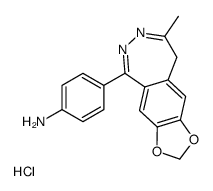1-(4-Aminophenyl)-4-methyl-7,8-methylenedioxy-5H-2,3-benzodiazepine hydrochloride

1-(4-Aminophenyl)-4-methyl-7,8-methylenedioxy-5H-2,3-benzodiazepine hydrochloride structure
|
Common Name | 1-(4-Aminophenyl)-4-methyl-7,8-methylenedioxy-5H-2,3-benzodiazepine hydrochloride | ||
|---|---|---|---|---|
| CAS Number | 192065-56-8 | Molecular Weight | 329.78 | |
| Density | N/A | Boiling Point | N/A | |
| Molecular Formula | C17H16ClN3O2 | Melting Point | N/A | |
| MSDS | USA | Flash Point | N/A | |
| Symbol |

GHS07 |
Signal Word | Warning | |
Use of 1-(4-Aminophenyl)-4-methyl-7,8-methylenedioxy-5H-2,3-benzodiazepine hydrochlorideGYKI 52466 hydrochloride is an orally active, highly selective and noncompetitive AMPA/kainate receptor antagonist with the IC50 values of 7.5 and 11μM, respectively. GYKI 52466 hydrochloride has good blood brain barrier permeability and anticonvulsant effect. GYKI 52466 hydrochloride can be used in Parkinson's disease research[1][2]. |
| Name | 4-(8-methyl-9H-[1,3]dioxolo[4,5-h][2,3]benzodiazepin-5-yl)aniline,hydrochloride |
|---|---|
| Synonym | More Synonyms |
| Description | GYKI 52466 hydrochloride is an orally active, highly selective and noncompetitive AMPA/kainate receptor antagonist with the IC50 values of 7.5 and 11μM, respectively. GYKI 52466 hydrochloride has good blood brain barrier permeability and anticonvulsant effect. GYKI 52466 hydrochloride can be used in Parkinson's disease research[1][2]. |
|---|---|
| Related Catalog | |
| In Vitro | GYKI 52466 hydrochloride (0.3-100 μM) inhibits inward currents activated by AMPA and Kainate receptor in cultured rat hippocampal neurons[1]. |
| In Vivo | GYKI 52466 hydrochloride (intraperitoneal injection; 1.76-13.2 mg/kg; once) treatment provides potent anticonvulsant protection against sound-induced seizures in DBA/2 mice[2]. |
| References |
| Molecular Formula | C17H16ClN3O2 |
|---|---|
| Molecular Weight | 329.78 |
| Exact Mass | 329.09300 |
| PSA | 69.20000 |
| LogP | 3.02130 |
| InChIKey | RUBSCPARMVJNKX-UHFFFAOYSA-N |
| SMILES | CC1=NN=C(c2ccc(N)cc2)c2cc3c(cc2C1)OCO3.Cl |
| Symbol |

GHS07 |
|---|---|
| Signal Word | Warning |
| Hazard Statements | H315-H319-H335 |
| Precautionary Statements | P261-P305 + P351 + P338 |
| Personal Protective Equipment | dust mask type N95 (US);Eyeshields;Gloves |
| Hazard Codes | Xn |
| Risk Phrases | 36/37/38 |
| Safety Phrases | 22-26-36 |
| RIDADR | NONH for all modes of transport |
| HS Code | 2934999090 |
| HS Code | 2934999090 |
|---|---|
| Summary | 2934999090. other heterocyclic compounds. VAT:17.0%. Tax rebate rate:13.0%. . MFN tariff:6.5%. General tariff:20.0% |
|
Activation of GluR6-containing kainate receptors induces ubiquitin-dependent Bcl-2 degradation via denitrosylation in the rat hippocampus after kainate treatment.
J. Thorac. Cardiovasc. Surg. 286 , 7669-80, (2011) We previously showed that Bcl-2 (B-cell lymphoma 2) is down-regulated in a kainate (KA)-induced rat epileptic seizure model. The underlying mechanism had remained largely unknown, but we here report f... |
|
|
GYKI 52466, a 2,3-benzodiazepine, is a highly selective, noncompetitive antagonist of AMPA/kainate receptor responses.
Neuron 10 , 51, (1993) In whole-cell voltage-clamp recordings from cultured rat hippocampal neurons, the 2,3-benzodiazepine GYKI 52466 was a potent antagonist of kainate- and AMPA-activated currents (IC50 values, 7.5 and 11... |
|
|
Differential antagonism of alpha-amino-3-hydroxy-5-methyl-4- isoxazolepropionic acid-preferring and kainate-preferring receptors by 2,3-benzodiazepines.
Mol. Pharmacol. 47 , 582, (1995) Whole-cell recordings were used to study the antagonism of alpha-amino-3-hydroxy-5-methyl-4-isoxazolepropionic acid (AMPA)-preferring and kainate-preferring receptors by 2,3-benzodiazepines. Current t... |
| 1-(4-Aminophenyl)-4-methyl-7,8-methylenedioxy-5H-2,3-benzodiazepine hydrochloride |